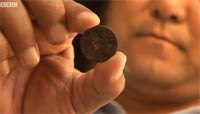 In August we posted about a joint Chinese-Kenyan expedition to locate the remains of a ship from the fleet of the legandary Chinese navigator, Zheng He. The ship was said to have sunk off Kenya near Lamu. Recently the team discovered Chinese pottery and an imperial coin in the Kenyan coastal village of Mambrui.
In August we posted about a joint Chinese-Kenyan expedition to locate the remains of a ship from the fleet of the legandary Chinese navigator, Zheng He. The ship was said to have sunk off Kenya near Lamu. Recently the team discovered Chinese pottery and an imperial coin in the Kenyan coastal village of Mambrui.
Could a rusty coin re-write Chinese-African history?
It is not much to look at – a small pitted brass coin with a square hole in the centre – but this relatively innocuous piece of metal is revolutionising our understanding of early East African history, and recasting China’s more contemporary role in the region.
A joint team of Kenyan and Chinese archaeologists found the 15th Century Chinese coin in Mambrui – a tiny, nondescript village just north of Malindi on Kenya’s north coast.
In barely distinguishable relief, the team leader Professor Qin Dashu from Peking University’s archaeology department, read out the inscription: “Yongle Tongbao” – the name of the reign that minted the coin some time between 1403 and 1424.
“These coins were carried only by envoys of the emperor, Chengzu,” Prof Qin said.
“We know that smugglers would often take them and melt them down to make other brass implements, but it is more likely that this came here with someone who gave it as a gift from the emperor.”
And that poses the question that has excited both historians and politicians: How did a coin from the early 1400s get to East Africa, almost 100 years before the first Europeans reached the region?
The answer seems to be with Zheng He, also known as Cheng Ho – a legendary Chinese admiral who, the stories say, led a vast fleet of between 200 and 300 ships across the Indian Ocean in 1418.
Then, a few years ago, fishermen off the northern Kenyan port town of Lamu hauled up 15th Century Chinese vases in their nets, and the Chinese authorities ran DNA tests on a number of villagers who claimed Chinese ancestry.
Thanks to Alexandre Monteiro on the Marine History List for pointing out the article.
